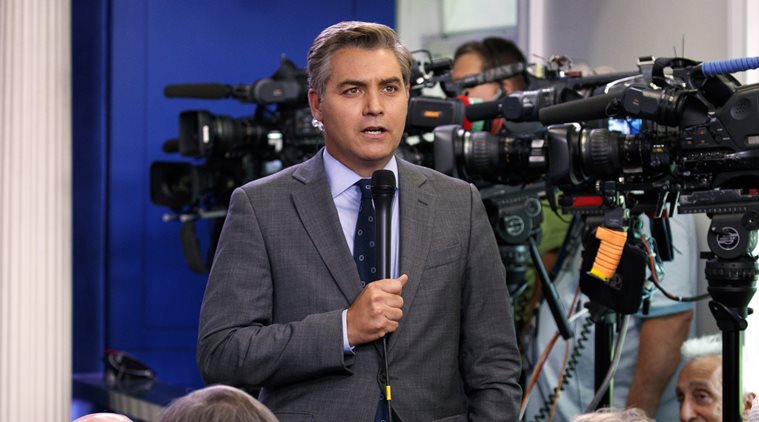No Easy Answers
CNN’s White House reporter is denied access to the President for asking difficult questions while a paper shows why the media must learn the elements of analytics and artificial intelligence

FILE – In this Aug. 2, 2018 file photo, CNN correspondent Jim Acosta does a stand up before the daily press briefing at the White House in Washington. (AP Photo/Evan Vucci, File)
Since the liveliest show on TV was the slanging match between the government and the Opposition over demonetisation, a question which was settled last year, let us seek diversion elsewhere, in bans across borders. On Wednesday, the US President clashed RPG (role-playing game)-fashion with CNN White House reporter Jim Acosta, who persistently asked uncomfortable questions. Why was there so much excitement about an “invasion” (that was the word Trump used last week) when the immigrant caravan he is presenting as an existential threat to America was still a thousand miles away? And what about the Russia investigation (Trump called it a “hoax”)? And so on.
The President decided that enough was enough and an aide tried to take the mike away from Acosta. He resisted, very gently, and was immediately accused of being a “rude, terrible person” unfit to work for CNN. Which could have been a backhanded compliment, since in Trump’s estimation, CNN is unfit to work at all as a news provider. When an NBC correspondent sprang to his colleague’s defence, saying that he was “a diligent reporter who busts his butt”, Trump replied, “I’m not a big fan of yours either, to be honest.”
The upshot is that Acosta is now the American equivalent of a tadipaar at the White House, and has been stripped of his access pass on the charge that he had reacted inappropriately by “placing his hands” on the intern. It’s a bit rich, coming from a President who has boasted of grabbing stuff with abandon. A series of Reuters pictures of the event gives a blow by blow account of the incident involving the mike, in which nothing inappropriate is visible. Back in his studio, Acosta said that he had never imagined that a US journalist would be denied access to his President for asking difficult questions. Well, stranger things are happening out there, and in several other countries. And it is frequently acceptable to a political consensus. Wonder where that comes from? A deep analysis of politically radicalised violence offers some answers.
Another mass shooting in the US, this time in California, follows on from two other incidents of terrorist violence last week — a pipe bomb campaign against critics of President Trump and a deadly attack on a synagogue. Internet forensics were used in the investigation of those crimes, but one hasn’t seen a deeper analysis of the digital system in which right-wing violence is being incubated. This is a ‘cloud’ of communications and connections. And as the weatherman knows, it is impossible to deliver an accurate storm warning without studying the clouds.
India also sees this phenomenon. There are now several fact-checking organisations which accurately call out fake news and real news images photoshopped into fake news, or untouched images and videos inserted into new contexts to give body to fake news. They also identify bots which amplify the communications of real users by copy-pasting across its zombie horde, and convey a false impression of numerical superiority. But the deeper forensics needed to map botnets and identify their owners (this is a crucial step in demonstrating bad faith), and to analyse how they connect with outlets of real news and ‘alternative facts’ to support their political agendas and run down detractors, is rarely seen in action. Maybe because it requires algorithms, statistics and artificial intelligence.
This is why a paper presented at the International AAAI Conference on Web and Social Media (ICWSM) is back in circulation. The event is an annual forum promoted by the Association for the Advancement of Artificial Intelligence, the premier venue for computational social science, and the lead author of the paper was Kate Starbird, assistant professor in the department of Human Centred Design and Engineering at the University of Washington. She and her students study the dynamics of social media as it responds to natural disasters and anthropogenic crises.
In the second category, they first focused on rumour and conspiracy theories surrounding the bombing of the Boston marathon in 2013, and identified a network of alternative media which feeds back and forth with regular media, but has developed an ecosystem of its own which competes with the latter. On their global network map, the clickbait site Beforeitsnews.com is equipotent with the The New York Times. In its heyday, the freshly banned conspiracy theory site Infowars.com was twice as influential as The Washington Post. This is sobering news.
Starbird’s paper, which is available on her site, offers numerous insights into the network which feeds fake news the world over, and into its dynamics. Reading it, a mass of anecdotal information that one encounters about the phenomenon suddenly falls into a pattern. And it becomes abundantly clear that to fight off the phenomenon, media cannot rely on feet on the street, but must learn the elements of analytics and artificial intelligence. That is the only reliable means to identify the purveyors and amplifiers of fake news.
pratik.kanjilal@expressindia.com






































No hay comentarios:
Publicar un comentario